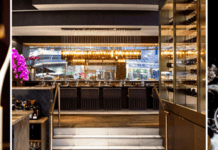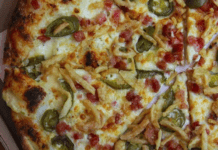When the meat cart rolls up to the table at Cut STEAKHOUSE in Halifax, beef lovers salivate. Not only does the elegant steakhouse dry-age its beef for 35 days, but the well-marbled choices on offer include a USDA Prime bone-in tenderloin ($49), a 32-oz. certified-organic, antibiotic- and hormone-free Alberta Black Angus bone-in striploin ($74), a boneless Australian Wagyu rib-eye ($100) and a boneless rib-eye from nearby Windsor, N.S. ($49).
Although the economy in Halifax, and the rest of the country, remains sluggish, and beef prices are on the rise, steak consumption has actually increased since 2008, according to the 2011 “Canadian Center of the Plate: Beef & Pork Consumer Trend Report” from Chicago-based Technomic Inc. In late 2010, nearly four-fifths of beef consumers said they eat steak once a month or more, the survey shows, compared to just three-quarters of beef consumers polled in 2008.
Our love of beef knows no bounds. Nine out of 10 Canadian carnivores eat beef at least once a week, Technomic reports, and a third of us crave a weekly fast-food burger. While the number of beef entrées has dropped slightly at limited- and full-service restaurants, beef continues to appear on menus, morning, noon and night. You’ll find meals such as steak and eggs for breakfast, braised-brisket sandwiches for lunch and a beef-topped pizza for dinner.
Beef remains the ultimate Canadian comfort food, but it also gives chefs an opportunity to create exciting dishes with old and new cuts. ABC Country Restaurants, based in Surrey, B.C., is a perfect example. ABC’s slow-cooked certified-Angus pot roast dinner ($14.99) rivals fish and chips and pasta as a top-selling entrée in the chain’s 30 restaurants in B.C. and Alberta, notes Lawrence Hawkins, food and beverage director.
Hawkins says customers have also embraced the Sirloin Filet Salad ($14.99), spring greens topped with tender charbroiled strips of “chicken muscle” — a small, sinewy offcut from the underside of the sirloin — garnished with candied pecans, feta cheese, strawberries and balsamic vinaigrette. “Not everybody wants a caesar salad with chicken,” he notes.
Duane Ellard, senior director of National Market Development for Canada Beef Inc., based in Calgary, says sirloin filet is one of many “hidden gems” from the beef carcass that allows chefs to differentiate their offerings. “Guests and operators are coming to realize there’s more to beef than a steak,” Ellard says.
By following the contour of the muscle instead of cutting across the grain, he says, beef packers and purveyors are isolating under-used tender muscles. “At the moment, there’s a limited supply of middle meats — the steaks we know and love,” he says. “But there’s a story to be told about shabu-shabu, bavette, tri tip and teres major,” some of the newer cuts.
Savvy operators are also putting a new spin on traditional comfort foods. “A simple twist may be the push that convinces customers to try a new food,” according to the Technomic survey.
Jan Koenig agrees. Koenig, co-founder of Calgary-based Humpty’s Family Restaurants, says the idea of serving shepherd’s pie in a skillet came from an employee recipe contest, and she decided to flip it. Her Upside Down Shepherd’s Pie ($12.25/$9.50) starts with a crisp layer of grilled mashed potatoes (she prefers McCain’s frozen) topped with Tex Mex-seasoned ground beef, corn, red onions, gravy and cheddar cheese, served with garlic toast. “It’s very simple, but it works very well,” she says.
Humble meatloaf, meanwhile, is getting a gourmet makeover with ground beef perceived as premium, such as Angus, which consumers say they’re willing to pay more to get. On its Urban Classics menu, Toronto-based Milestones Grill & Bar lists an ultra-premium Kobe-style meatloaf over garlic mashed potatoes ($19.99), accompanied by shiitake-mushroom jus, lightly fried onion strings and seasonal vegetables.
Globally inspired sauces, marinades and spices beyond tried-and-true Italian also help operators differentiate their beef entrées. Technomic finds 42 per cent of consumers now prefer teriyaki as a glaze or marinade for beef. At full-service restaurants, garlic, onions and tomatoes become a base for bold barbecue flavours, infusing braised and slow-roasted beef. Females indicated a strong preference for sweet honey and tangy barbecue flavours.
One way to introduce an ethnic cuisine is by starting with a single ingredient or entrée accompaniment. Gordon Mackie, director of Culinary Development for Toronto-based SIR Corp., says the chipotle-marinated sirloin steak topped with goat-cheese butter, ($24.95) at the company’s Canyon Creek Chophouse brand, is so popular, he wouldn’t dream of taking it off the menu.
Chains such as Canyon Creek are also beefing up appetizers so even cash-strapped customers can enjoy a hearty bite. Mackie’s new prime-rib sliders ($12.95) are mounded with shaved prime rib aged 40 days and served with cabernet jus on a freshly baked spiced bun. Prime-rib quesadillas ($10.95) pair the same beef with Tabasco-spiked sautéed onions and Applewood-smoked bacon. “We have such great success with our prime-rib sandwich,” says Mackie. “We wanted to offer more of it at a lower price to get away from the traditional steakhouse shrimp cocktail and enhance our bar experience.”
As part of its new Casual Plates menu, Richmond, B.C.-based Keg Steakhouse & Bar is offering tenderloin skewers ($14.95), accompanied by grilled vegetables and a horseradish Dijon dipping sauce. Doug Smith, COO of Keg Restaurants Ltd., says the skewers are already a favourite. “These menu items really encourage guests to enjoy our Keg bars,” he says.
Better Burgers
With suppliers segregating beef into grinds such as sirloin, chuck, prime rib and round, chefs have a great opportunity to “upscale” burgers with interesting condiments and sauces on a great bun, explains Canada Beef’s Ellard. The result is an explosion of hand-crafted gourmet burgers, particularly in full-service restaurants, that shows no sign of fizzling.
Two out of five Canadians surveyed by Technomic say they not only want burgers made of premium meat, but they’re willing to pay more for what’s not in their beef. “More consumers in Canada than in the U.S. said they would seek out and pay more for hormone- and antibiotic-free beef,” according to the results.
Toronto real-estate developer Shane Baghai bought his own herd just west of the city to ensure the Angus, Highland and Wagyu cattle at his three-month-old Paradise Farms Café were not administered growth hormones. Full-page ads for his meat and café appear regularly in the Toronto Star. Guests can customize their haute burger with 15 to 20 free condiments, including sautéed mushrooms and caramelized onions.
Hero Certified Burgers, meanwhile, advertises its Heritage Angus beef, raised by a group of ranchers in B.C. and Alberta, as range-fed, hormone- and antibiotic-free and halal-certified. “Our burger has attributes nobody else has,” says John Lettieri, the chain’s president, who launched Hero in Toronto in 2003 and expects to have 50 franchises open by the end of the year. “It’s all about the well-being of the animal,” he says, “which we believe translates into flavour.”
Hero’s informative website, complete with panoramic shots of mountains and cowboys, invites customers to email a rancher directly. Of the four-, six- and eight-ounce beef burgers on offer, Lettieri says the six-ounce patty for $5.99 is the most popular.
Steak rules
When it comes to beef for dinner, three out of four consumers polled by Technomic said they would be “highly likely” to order steak. They also said they’d prefer to enjoy it at a wood-panelled men’s club or a casual steakhouse such as The Keg, which recently introduced a 20-oz. bone-in rib steak ($34.95).
While Alberta’s booming oil industry is keeping Calgary steakhouses full, Toronto’s independent steakhouses are disappearing, says Arron Barberian, whose late father, Harry, opened the storied Barberian’s downtown in 1959.
“Margins are thinning, sales are flat and the cost of high-quality protein is going through the roof,” says Barberian, who recently raised his prices by $2 a steak, and is reluctantly considering charging extra for side dishes. “We depended on customers buying fine wine and spirits to offset what we really should be charging,” he says. “People who once spent $300 for a bottle of wine are now spending $100.”
Barberian’s bestseller is a 16-oz. rib steak ($44.50), and he’s proud to support local farmers. About 60 per cent of his beef is raised in Ontario, compared to 25 to 30 per cent in the past.
Alternatively, despite Halifax’s poor economy, Cut Steakhouse has expanded its steak selection dramatically, to rave reviews. “When we opened four years ago, people would ask where our beef was from, and if it was organic,” says Shannon Bruhm, vice-president of Operations for RCR Hospitality Group, the restaurant’s parent company. “Now that we have certified-organic beef from Spring Creek, Alta., as a menu option, a large percentage of the population is interested.”
Adding local beef to Cut’s menu has also paid off. “The rest of our steaks have a certified pedigree,” Bruhm says, “but this is just local beef from Windsor, dry-aged 35 days. I’m surprised at how high the demand is.” Offering more options also encourages customers to try two steaks side by side, he says.
Whether operators choose local or imported beef, no-name or pedigreed, the menu opportunities for one of our favourite proteins continue to expand. If pot roast doesn’t fit the bill, let them eat steak!
Keep Reading
Subway to Open First Vegetarian-Only Resto
Pork Steals Spotlight in Canadian Restaurants
FoodPlus: Beef (Expanded Coverage of Beef)




















